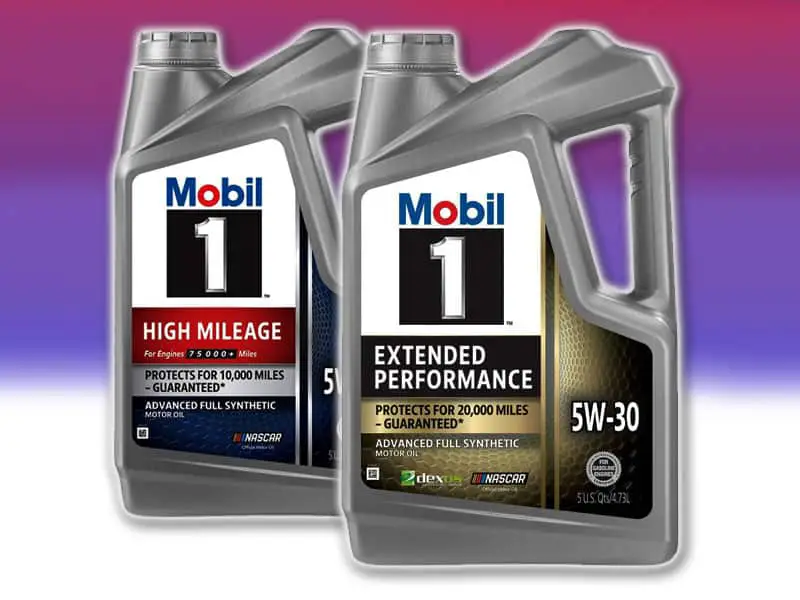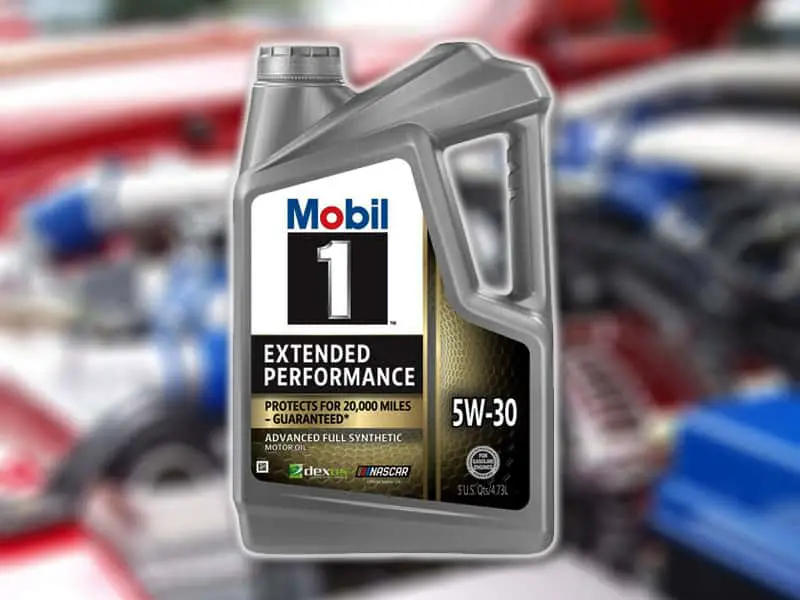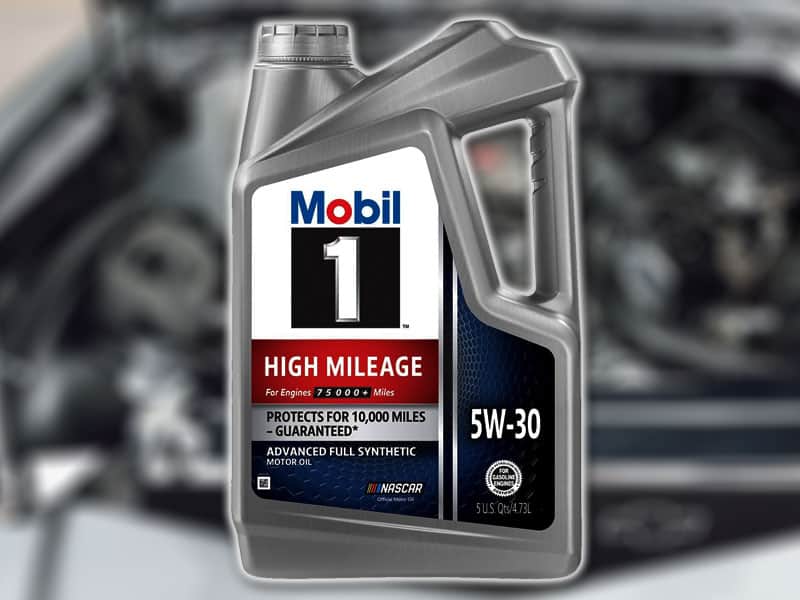Both the oils are fully synthetic used to serve gasoline engines only. Mobil 1 Extended performance focal point is wearing protection while High Mileage emphasizes mainly on cold startups.
Extended performance provides excellent protection against sludge build-up. Higher concentrations of anti-wearing additives give resistance against the wearing and tearing of the engine. Its performance at medium and higher temperatures is also quite dominant. Higher TBN enables longer oil changing durations enhancing fuel economy.


High Mileage has less ZDDP ash formation proving to be more catalytic converter friendly. Calcium and magnesium-based detergents are present in good numbers to provide resistance against sludge formation. Anti-wearing agents are present in decent concentrations to lower the engine wearing. It lowers the pre-ignition of oil, protecting it from quick burning. It also provides quite impressive performance in colder situations.

| Statements | Mobil 1 Extended Performance (5W-30) | Mobil 1 High Mileage (5W-30) |
| Kind of Oil | Entirely Synthetic | Entirely Synthetic |
| Category of Engine | Gasoline | Gasoline |
| Viscosity grades accessibility | 0W-20, 5W-20, 5W-30, 10W-30 | 0W-20, 5W-20, 5W-30, 10W-30, 10W-40 |
| ILSAC | GF-5 | GF-6 |
| API | SN, SM, SL, SJ | SN, SN PLUS |
| Cost (1 Quart.) | 8.96 $ | 7.80 $ |
| Oil change frequency (miles) | 15,000-20,000 | 10,000 |
| Supplements | Anti-wear, Detergents, Dispersants, Anti-oxidants | Detergents, Dispersants, Anti-foam agents, Anti-wears |
| ACEA | A5/B5 | A5/B5 |
Table of Contents
Contrasting Early Burning Protection of oil
Higher concentrations of lighter molecules in the oil cause its quick burn-off. This is because these lighter molecules won’t be able to resist high temperatures. The high temperature causes these molecules to break down easily, increasing oil volatility.
High mileage has a higher flashpoint which indicates that it has low volatility, therefore, it provides better protection from pre-burning of oil. Meanwhile, the lower flashpoint of Extended performance indicates that it has a higher number of lightweight molecules which break down easily making it more volatile.
| Contrasting Oils (5W-30 Grade oils) | Flashpoint Temperature (o C) |
| Mobil 1 Extended Performance | 230 |
| Mobil 1 High Mileage | 245 |
Contrasting Wear-off Protection
Anti-wearing agents are added to the oil to lower the problem of engine wearing. The function of these additives is to build a thin layer on the moving engine components which restricts them from skidding over one another, minimizing the friction. Higher concentrations of these additives will form more firm layers around these moving parts providing better lubrication and higher wearing protection.
Zinc and phosphorus are mainly present in both these oils as anti-wearing additives. Extended performance, however, contains both of them in higher amounts. The amount of boron and molybdenum-based additives are also faintly more in Extended performance. Small traces of titanium are also found in both these oils. Overall, High Mileage is behind its rival in terms of wearing protection.
| Contrasting Oils (5W-30 Grade oils) | Amount of Zinc (ppm) | Amount of Phosphorus (ppm) | Amount of Boron (ppm) | Amount of Molybdenum (ppm) | Amount of Titanium (ppm) |
| Mobil 1 Extended Performance | 872 | 757 | 102 | 81 | <1 |
| Mobil 1 High Mileage | 822 | 690 | 95 | 79 | <1 |
Viscosity Comparison
The hindrance in the movement of the fluid is called kinematic viscosity. The oil performance will be better if it has a greater kinematic viscosity. Viscosity index, on the other hand, depicts the change in viscosity of oil upon temperature variations. This viscosity index is needed to be high for providing more stable viscosity at elevated temperatures. The working of any oil in cold conditions is characterized through the pour point. It is the lowest temperature below which fluid stops flowing.
Kinematic viscosity of Extended performance is high at both 40 o C and 100 o C providing superior performance at both the respective temperatures. Both the oils have a similar viscosity index which indicates that their viscosities will be equally affected when the temperature rises. High mileage is better for cold startups due to its low pour point.
| Contrasting oils (5W-30 Grade oils) | Kinematic Viscosity at 40 o C (cSt) | Kinematic Viscosity at 100 o C (cSt) | Viscosity index (VI) | Pour point temperature (o C) |
| Mobil 1 Extended Performance | 67.5 | 11.6 | 168 | -40 |
| Mobil 1 High Mileage | 60.9 | 11.2 | 168 | -45 |
Comparing the Catalytic Converter performance
Oxidation of the oil turns zinc and phosphorus compounds into poisonous ash. This ash enters into catalytic converter and clogs it. It further results in obstruction in the performance of catalytic converter, making it less efficient.
Extended performance contains high quantities of both zinc and phosphorus. High mileage produces comparatively less ash due to the lower concentration of both these compounds. As a result, it is better with regard to catalytic converter.
| Contrasting Oils (5W-30 Grade oils) | Amount of Zinc (ppm) | Amount of Phosphorus (ppm) |
| Mobil 1 Extended Performance | 872 | 757 |
| Mobil 1 High Mileage | 822 | 690 |
Sludge Build-up Reduction Comparison
A black viscous fluid known as sludge is produced when the oxidized oil comes in contact with the moisture or any other impurity. Detergents along with dispersants are added to resist and protect the engine from this sludge build-up. Higher concentrations of these additives lead to more engine protection and lower sludge formation.
Extended performance has a very high number of calcium-based detergents. Magnesium quantity is marginally lower compared to its counterpart. The sodium quantity is also slightly high. Small traces of silicon, which is being added to the oil as an anti-foaming agent, are also present in this oil.
High mileage contains detergents and dispersants mainly based on calcium and magnesium to clean up the sludge. Sodium concentration, compared to its counterpart, is low. Higher concentrations of silicon provide better resistance against the foaming problem.
| Contrasting oils (5W-30 Grade oils) | Amount of Sodium (ppm) | Amount of Magnesium (ppm) | Amount of Calcium (ppm) | Amount of Silicon (ppm) |
| Mobil 1 Extended Performance | 8 | 711 | 1167 | 6 |
| Mobil 1 High Mileage | 4 | 725 | 1049 | 8 |
Contrasting regularity of oil exchange
The alkaline additives being added to the oil are estimated from TBN (Total Base Number). The purpose of their addition is to counterbalance the acid formations in the time ignition process. With the passage of time, the concentration of these additives starts decreasing which ultimately leads to the oil changing process. Higher TBN oil will provide longer durations of changing the oil.
The higher TBN of Extended performance shows more concentrations of alkaline additives. So, its oil changing interval falls between 15,000 to 20,000 miles, providing a longer oil changing span. High mileage has a relatively lower TBN, giving a higher oil changing frequency, after every 10,000 miles duration.
| Contrasting oils (5W-30 Grade oils) | TBN (Total Base Number) mg KOH/g |
| Mobil 1 Extended Performance | 8.6 |
| Mobil 1 High Mileage | 8.0 |
Quick Summary
- Both are entirely synthetic oils made to be utilized for gasoline engines only.
- Low formation of ZDDP ash in High Mileage allows it to provide better working of a catalytic converter.
- Extended performance will provide better cleaning of the sludge due to its higher detergents and dispersants concentrations.
- Foaming resistance of High Mileage oil is slightly higher.
- High Mileage provides more protection against early burn-off because of its high flash point temperature.
- Extended performance has more concentrations of anti-wearing additives so it provides better lubrication and lower engine wearing.
- Kinematic viscosity of Extended performance is high at 40 o C as well as at 100 o C.
- High Mileage is better in cold and chilly situations.
- Extended performance has lower oil changing frequency because of its high TBN.
- High Mileage is cheaper than its rival, so it is more economical and budget-friendly.